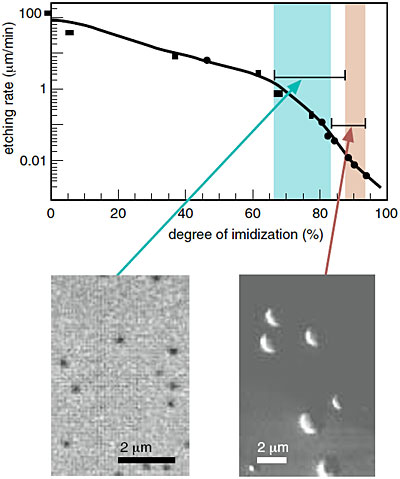When polymeric materials are irradiated by heavy ions, the substrate along the ion-path through films sustains damage because of scission of the polymer main chains. The damaged area can be chemically etched out to create ion track membranes which possess cylindrical pores having a nanometer scale diameter. However, an ion track membrane of thermally stable polyimide which could be applied to electronic devices has not been obtained by alkaline etching. In the present work, we have succeeded in preparing an ion track membrane by ion beam irradiation of a precursor film with precise control of the degree of imidization.
In partially imidized films prepared at 150degree Celsius, ion beam irradiation has been used to produce a negative, hemispheric-structured image with a 1.0 micrometer height and a 1.5 micrometer diameter (Fig. 6-1). In contrast, a positive pattern of 0.3 micrometer diameter holes was found to appear on a partially imidized film prepared at 145degree Celsius (Fig. 6-2). By precise control of the degree of imidization, positive and negative images can be prepared from precursor films with a 67-83% and an 89-94% degree of imidization, respectively.
The selection of positive or negative images is thought to be controlled by slight changes in the balance of scission and crosslinking of the polymer chains. Furthermore, the most contrasty hole patterns were obtained from partially imidized films that included a radiation-degradable sulfonyl group in the main chain. Positive and negative images embedded in thermally stable films are thought to be applicable to electronic devices and micro-machines for nanotechnology, respectively.
|

